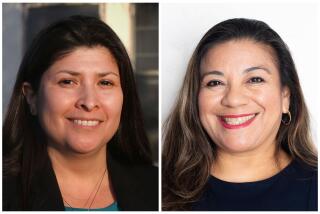L.A. Unified exemplifies the forces that stifle public school reform

- Share via
By now, Los Angeles Unified was supposed to be the technological model for big-city school systems.
All of its pupils would have iPads, teachers could access student data with the click of a mouse, and parents could check their children’s attendance and grades daily online.
But the student data and tracking system stumbled out of the gate three weeks ago when the new school year began. On some campuses teachers had no rosters, student schedules were scrambled and classrooms were either empty or overflowing. The computer system was so overloaded, it couldn’t process simple commands.
And the iPad project — the crown jewel of Supt. John Deasy’s reform campaign — was bungled so badly in its rollout last year that district-wide expansion was scaled back, then scrapped this week in the midst of concerns that the contracting process was tilted toward companies Deasy favored.
So instead of a groundbreaker, the district has become a national model of the tensions that stifle public school reform. Our technology projects were stranded between high-minded ideals and grass-roots realities; tripped up by jockeying over priorities, politics and power.
::
Deasy is devoted to reforming the district and he won’t apologize for that. He sees education as a social justice issue; his job is to level the playing field for underprivileged kids.
He gets high marks around the country for his passion and his zeal. But inside the district, the superintendent is considered by many to be self-righteous and thin-skinned. Community groups praise his advocacy, but the teachers union considers him an adversary.
Union president Alex Caputo-Pearl blames Deasy’s “autocratic style” for the technology missteps. He said Deasy’s inner circle minimized early reports of problems and rejected teachers’ suggestion that the student tracking system be phased in.
The union leader wants a team of parents, teachers, students and staff to consult with district leaders on future tech projects. But Deasy, he said, wants to limit their power. That battle is likely to play out during negotiations over contracts for teachers, who complain that too little attention is paid to instruction and too much to technology.
The district’s technology czar, Ron Chandler, insists the beleaguered new data system will win over its detractors. He admits it may have been rushed and apologized for the problem-plagued rollout. But the problems owed less to lack of input than lack of consensus, he said. “We had really good positive dialogue, but it was hard to get agreement on some things.”
That’s partly because the computer system is so large and so complex. But it’s also emblematic of a district where professional conflicts and personal agendas have outsized influence.
Chandler walked me through the tech project, explaining the need for an interface, the importance of owning the code, the efficacy and functionality of various modules.
I understood none of that. But I do understand the teachers’ frustration over error messages, blank screens and long waits to input data.
The computer network “maxed out” on the second day of school, Chandler said. “Everybody’s trying to use the system... They’re waiting in a long virtual queue, and all they see is that spinning wheel” on the computer screen.
I see a metaphor for L.A. Unified in that stalled computer example.
We root for progress, but all we see is a perpetually spinning wheel, delaying or derailing whatever new scheme is supposed to fix our schools.
::
I don’t think Deasy understands that his benevolent dictator persona — whether that’s valid or not — is costing him public support.
He ought to get credit for successfully promoting important ideals — like a revamp of school discipline practices and increased financial support for struggling schools.
But he loses points when he casts his opponents as enemies of children’s civil rights. Deasy doesn’t have a monopoly on wanting the best for Los Angeles students. In order to run a district this large, you have to do a lot of listening. That is not the strong suit of our hard-charging superintendent.
“John Deasy is impatient,” said school board member Tamar Galatzan, a Deasy supporter. “That is one of his greatest flaws, and also probably what’s driving him to push so hard.
“He believes, as many of us do, in making technology accessible to every kid ... And he wants that to happen five minutes ago,” Galatzan said. “He has a vision and no one can get there fast enough for him. He underestimates how long it takes in LAUSD to turn the ship even a few degrees.”
Deasy told me this week that he’s trying “to build a more collaborative process.” Still, it’s going to be hard for him to erase the stain of the iPad fiasco.
He hasn’t acknowledged that things have gone wrong in ways that are bigger than a few embarrassing emails or computer programming glitches.
The hitch in the iPad program is not merely a pause to correct “suboptimal” measures, as Deasy likes to insist. It’s a rebuke of his way of doing business. And that’s what he needs to fix.
I think he gets that intellectually, but it goes against his grain: “I understand it’s better to be more deliberative and engage more people,” he said. “But you then have to compromise speed... How many more years do you allow kids to graduate without the technology [skills] they need?”
That’s a valid question. But a better question for Deasy to ponder now is what kind of superintendent does this school district need.
[email protected]
Twitter: @SandyBanksLAT
More to Read
Sign up for Essential California
The most important California stories and recommendations in your inbox every morning.
You may occasionally receive promotional content from the Los Angeles Times.











